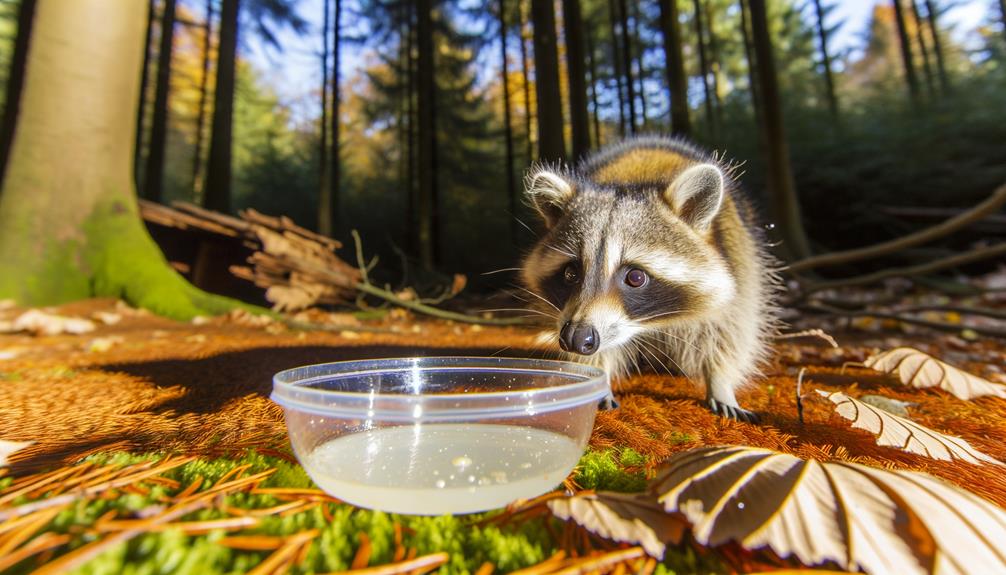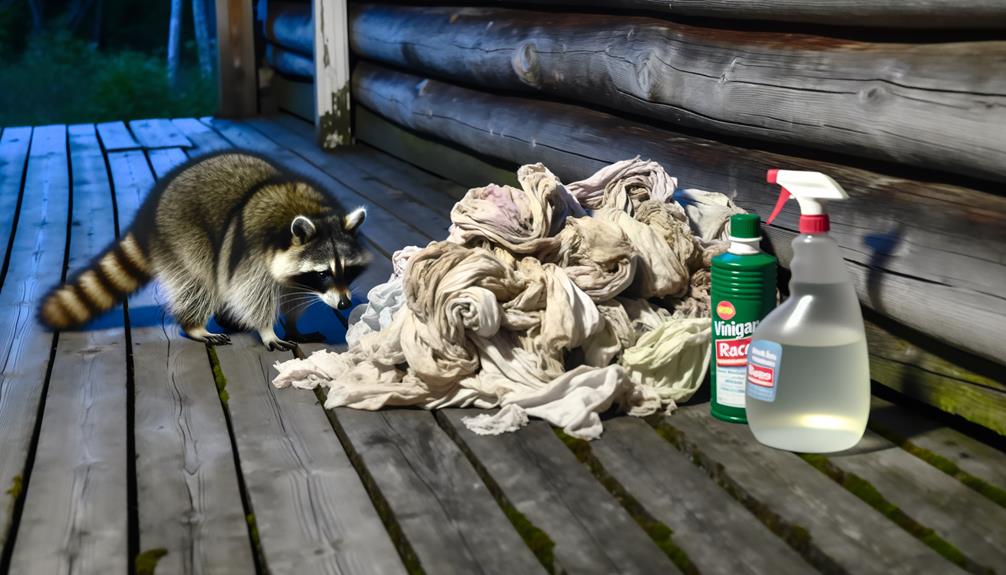Do Raccoons Like the Smell of Vinegar?
Raccoons typically find the smell of vinegar disagreeable due to its acetic acid content, which interferes with their well-developed olfactory senses. This interference is effective in decreasing foraging behavior, making vinegar a popular choice for discouraging raccoons from gardens and trash bins.
However, its effectiveness varies and may be short-lived as raccoons can become accustomed to the scent over time. For best results, vinegar is frequently combined with other deterrent methods, such as essential oils or physical barriers.
Further investigation into combining multiple strategies can improve comprehension of long-term raccoon deterrence.

Key Takeaways
- Raccoons generally find the smell of vinegar unpleasant due to its strong acetic acid content.
- Vinegar disrupts raccoons' olfactory senses, making it an effective short-term deterrent.
- Raccoons' avoidance of vinegar-based repellents has been observed around garbage bins and gardens.
- Regular reapplication of vinegar is necessary for sustained effectiveness in deterring raccoons.
- While cost-effective and non-toxic, vinegar's effectiveness may diminish over time due to habituation.
Raccoon Behavior Overview

Raccoon behavior is characterized by their nocturnal activity, omnivorous diet, and highly adaptable foraging strategies. These mammals exhibit crepuscular tendencies, being most active during twilight hours.
Their diet is diverse, encompassing plant material, small invertebrates, and human refuse. Foraging behavior is marked by remarkable dexterity and problem-solving skills, allowing raccoons to exploit a variety of food sources.
Raccoons possess acute olfactory senses, which play an essential role in locating sustenance during nighttime activities. They exhibit a high degree of environmental plasticity, thriving in urban, suburban, and rural habitats.
Understanding raccoon behavior is vital for evaluating their interactions with human environments, particularly in relation to attractants and deterrents, such as specific odors and food sources.
Vinegar Properties
Vinegar, a solution mainly composed of acetic acid and water, is characterized by its pungent odor and acidic properties, which can influence its interaction with various organisms.
The concentration of acetic acid typically ranges from 4% to 8% by volume, contributing to its low pH value, generally between 2 and 3. This acidity can disrupt cellular processes in microorganisms, making vinegar an effective antimicrobial agent.
Additionally, the volatile compounds responsible for vinegar's strong smell can act as irritants to the olfactory receptors of both humans and animals. These chemical properties not only make vinegar a versatile household product but also suggest potential implications for its use in influencing animal behavior, including that of raccoons.
Common Raccoon Deterrents

Understanding common raccoon deterrents involves examining natural repellents, evaluating the effectiveness of commercial solutions, and exploring various DIY methods.
Each approach offers distinct mechanisms to mitigate raccoon activity, ranging from olfactory repellents to physical barriers.
This section will provide an objective analysis of these methods, emphasizing their practical applications and limitations.
Natural Repellents Overview
Given the increasing need for humane and environmentally friendly wildlife management, natural repellents have gained prominence as viable solutions for deterring raccoons effectively. Among these, substances such as vinegar, ammonia, and predator urine are commonly employed.
Vinegar, due to its acetic acid content, emanates a pungent odor that raccoons find unpleasant, thereby discouraging their presence. Ammonia mimics the scent of predator urine, creating an inhospitable environment for raccoons. Additionally, essential oils like peppermint and eucalyptus are utilized for their strong, repellent properties.
These natural deterrents offer the advantages of being non-toxic and biodegradable, ensuring minimal environmental impact. Employing such methods can mitigate human-wildlife conflicts while preserving ecological balance.
Commercial Solutions Effectiveness
Commercial raccoon deterrents, such as ultrasonic devices and chemical repellents, offer varied levels of efficacy in mitigating raccoon intrusion. Ultrasonic devices emit high-frequency sounds intended to dissuade raccoons, exploiting their sensitive auditory systems. However, empirical studies reveal mixed results, as raccoons may habituate to these sounds over time.
Chemical repellents, typically containing naphthalene or ammonia, work by creating unpleasant olfactory stimuli. While initial application may show success, environmental factors such as rain can reduce their longevity and effectiveness. Additionally, improper use of chemical deterrents can pose risks to non-target species and the environment.
Therefore, while commercial solutions can be part of an integrated pest management strategy, their limitations necessitate supplementary methods for sustained raccoon control.
DIY Deterrent Methods
Homeowners often turn to DIY deterrent methods, leveraging common household items such as vinegar, ammonia, and motion-activated lights to repel raccoons effectively. These methods utilize sensory aversion and environmental modifications to create an inhospitable environment for raccoons. Vinegar's acetic acid can irritate raccoons' sensitive olfactory receptors, while ammonia mimics the scent of predators' urine. Motion-activated lights startle nocturnal raccoons, disrupting their foraging behavior.
Some effective DIY deterrents include:
- Vinegar-soaked rags: Place around entry points.
- Ammonia solution: Apply in areas frequented by raccoons.
- Motion-activated lights: Install near garbage bins and gardens.
- Ultrasonic repellents: Emit high-frequency sounds that deter raccoons.
These methods offer a cost-effective and environmentally friendly approach to raccoon control.
Raccoons and Smells
Raccoons possess highly developed olfactory senses, which play an essential role in their ability to locate food and navigate their environment. The olfactory epithelium in raccoons is densely populated with sensory neurons, allowing them to detect a wide spectrum of scents with high sensitivity.
This advanced olfaction aids in the identification of food sources, even those that are well-concealed or underground. Moreover, raccoons utilize their keen sense of smell for social communication, marking territory, and recognizing potential threats. The vomeronasal organ (VNO) enhances their ability to detect pheromones, contributing to intra-species interaction.
Understanding the olfactory capabilities of raccoons is fundamental for developing effective management strategies that leverage their sensory strengths.
Vinegar as a Deterrent

Utilizing the acetic acid present in vinegar, researchers have explored its efficacy as a potential deterrent for raccoons due to its pungent and aversive odor. The premise is based on the hypothesis that the strong smell of acetic acid could disrupt raccoons' olfactory senses, making environments less appealing.
Various applications of vinegar as a deterrent have been proposed, including:
- Spraying vinegar around garbage cans: This aims to prevent raccoons from scavenging.
- Soaking rags in vinegar: Placing these rags in strategic locations to create a barrier.
- Vinegar-soaked cotton balls: Positioned in attics or basements to deter entry.
- Direct application to surfaces: Especially in areas frequented by raccoons.
These methods leverage vinegar's chemical properties to achieve effective wildlife management.
Scientific Studies on Vinegar
Empirical research investigating the repellent properties of vinegar has produced mixed results, calling for further studies to establish its efficacy in wildlife management.
Various controlled experiments have tested vinegar's potential to deter raccoons and other mammals, often using acetic acid concentrations ranging from 5% to 10%. Some studies suggest that the acetic acid in vinegar can irritate the olfactory receptors of raccoons, thus discouraging their presence.
However, other research indicates that the effect is inconsistent, with raccoons displaying habituation over time. Variables such as environmental conditions, raccoon habituation, and vinegar application methods contribute to these inconsistent outcomes.
A more thorough and methodologically rigorous approach is needed to determine vinegar's true potential as a raccoon deterrent.
Vinegar Application Methods

Given the mixed results from empirical studies, it is important to examine the various methods of vinegar application to understand their potential effectiveness in deterring raccoons.
Several application techniques have been explored, each with its own set of procedural nuances and effectiveness metrics.
- Direct Spraying: Applying vinegar directly to areas frequented by raccoons.
- Soaked Rags: Placing vinegar-soaked rags in strategic locations.
- Vinegar Traps: Using containers filled with vinegar to create localized high-concentration zones.
- Vinegar Solutions: Mixing vinegar with water and spraying over larger areas to increase coverage.
These methods vary in their capacity to maintain vinegar's olfactory potency, thereby influencing their effectiveness in raccoon deterrence.
Further analysis is necessary to determine the most suitable application method based on specific situational requirements.
Effectiveness of Vinegar
The effectiveness of vinegar as a raccoon deterrent hinges on its ability to disrupt the animal's sensory perception, particularly its olfactory system. Vinegar's acetic acid content produces a pungent odor that can overwhelm raccoons' sensitive sense of smell, creating an aversive environment.
Scientific observations suggest that the intensity of vinegar's scent can mask other appealing odors, such as food, thereby reducing raccoon foraging behavior. Empirical evidence, however, remains limited and largely anecdotal. It indicates that while vinegar may provide short-term deterrence, its efficacy diminishes over time as the scent dissipates.
For sustained results, regular reapplication is necessary. Hence, while vinegar can serve as a temporary measure, its long-term effectiveness in raccoon deterrence remains subject to further investigation.
Alternatives to Vinegar

In evaluating alternatives to vinegar, citrus-based repellents and essential oil solutions merit consideration due to their strong olfactory properties. Citrus-based repellents utilize the natural aversion raccoons have to the scent of citrus fruits, providing an effective deterrent.
Similarly, essential oil solutions, particularly those containing peppermint or eucalyptus, exploit the sensitivity of raccoons to potent aromatic compounds.
Citrus-Based Repellents
Surprisingly, citrus-based repellents have garnered attention as effective alternatives to vinegar in deterring raccoons due to their potent olfactory properties. These repellents leverage the strong, acidic scent of citrus fruits, which raccoons find highly unpleasant.
The efficacy of citrus-based repellents is supported by studies highlighting their impact on raccoon behavior and avoidance patterns. Utilizing citrus peels or commercially available citrus sprays can create an inhospitable environment for these nocturnal pests.
Key benefits of citrus-based repellents include:
- Natural Composition: Made from organic citrus extracts, minimizing environmental impact.
- Non-Toxicity: Safe for humans and pets, unlike chemical deterrents.
- Ease of Application: Simple to apply around gardens and entry points.
- Dual Functionality: Acts as a deterrent while adding a pleasant scent to surroundings.
Essential Oil Solutions
Essential oil solutions, such as those derived from peppermint, eucalyptus, and lavender, offer a scientifically supported and effective alternative to vinegar for repelling raccoons. These essential oils contain compounds like menthol, eucalyptol, and linalool, which are known to be deterrents to various wildlife due to their strong aromatic properties.
When applied in appropriate concentrations, these oils can disrupt the olfactory senses of raccoons, making the environment less appealing. Research indicates that essential oils can be integrated into sprays or diffusers to create a persistent barrier.
Additionally, essential oils are biodegradable and pose minimal environmental risk, providing a sustainable approach to wildlife management. This method guarantees a humane and environmentally conscious solution to raccoon intrusion.
Combining Deterrent Methods
Integrating multiple deterrent strategies can greatly enhance the effectiveness of raccoon management efforts. Employing a combination of sensory, physical, and behavioral interventions can create a multifaceted defense system. This approach not only increases the likelihood of deterring raccoons but also mitigates the limitations of any single method.
- Olfactory deterrents: Utilizing strong-smelling substances like vinegar and essential oils.
- Physical barriers: Installing raccoon-proof fencing or securing garbage bins.
- Auditory repellents: Employing noise-making devices that emit high-frequency sounds.
- Behavioral modifications: Removing food sources and maintaining cleanliness to reduce raccoon attraction.
Personal Experiences and Stories

Anecdotal evidence from various homeowners and wildlife experts provides valuable insights into the efficacy of vinegar as a raccoon deterrent. Numerous individuals report that applying vinegar around garbage bins and garden perimeters reduces raccoon activity to a notable extent.
Wildlife specialists corroborate these claims, suggesting that the acetic acid in vinegar disrupts raccoons' olfactory senses, creating an inhospitable environment. However, it is essential to note that some raccoons exhibit habituation, diminishing the deterrent's effectiveness over time.
Additionally, the method's success appears to vary based on the concentration of vinegar and frequency of application. While not universally foolproof, these personal accounts underscore vinegar's potential as a cost-effective, non-toxic component in integrated pest management strategies.
Conclusion
The olfactory aversion of Procyon lotor to acetic acid solutions, commonly known as vinegar, has been examined with a focus on its potential utility as a deterrent. While empirical evidence suggests some degree of efficacy, it is not universally reliable.
Complementary strategies should be considered to enhance deterrence. The multifaceted nature of raccoon behavior necessitates a holistic approach, integrating various deterrents to achieve best outcomes in mitigating human-wildlife conflicts.
Further research is warranted to refine these methods.






